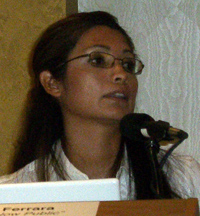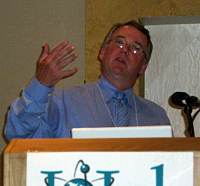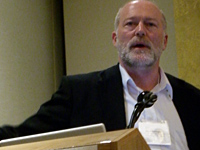Olivia Garcia, Managing Editor, Bakersfield Californian’s Mercado Nuevo
Steve Yelvington, Vice President of Strategy and Content, Morris Communications
Kyle Leonard, Managing Editor, Chicago Tribune’s TribLocal.com
“I’m calling my talk ‘Different Strokes for Different Folks.'”
 Olivia Garcia is the editor of several citizen journalism sites launched by the Bakersfield Californian in order to reach new audiences. The 140-year old paper has a daily circulation of 60,000 and 72,000 on weekends.
Olivia Garcia is the editor of several citizen journalism sites launched by the Bakersfield Californian in order to reach new audiences. The 140-year old paper has a daily circulation of 60,000 and 72,000 on weekends.
Launched in 2004, NorthWestVoice was the first citizen media publication created by a U.S. newspaper. It has more than 3,000 online users and some of the material is published in a print edition which is delivered to 30,000 homes and schools. The site attracts lots of stay-at-home moms. “The editor is really the cheerleader for the paper, the crusader,” explained Garcia. “She reviews all the content but doesn’t really change it beyond fixing some typos or minor mistakes.”
The Californian now publishes the SouthWestVoice as well, where, Garcia said, contests, celebrations and school news are a big hit.
The Californian also published Mas, which Garcia called “affirmational media for Latinos.” The site keeps the Latino community connected through an ongoing discussion of cultural issues.
And there’s Bakotopia, a more free-form site and 100 percent user-generated magazine for the downtown crowd. “It’s a vibrant online community with 200 bands, 4,000 profiles, hundreds of blogs. We unveiled a print edition in May 2007 that we distribute through racks on campus, libraries, bars and tattoo parlors.”
Garcia said that there’s no right or wrong way to get the community involved in these Web sites, but the editors can’t spend all day behind computer screens; they have to get out of the office, do outreach, go to events, organize events for the community, and all along, keep an open mind. “The community is telling us what’s important and we’re learning a lot,” she said.
“We don’t call people citizen journalists. We call them citizen contributors. Some say that sounds like you write for the Daily Worker, so we might change to community contributor.”
 Kyle Leonard of TribLocal said that most of The Chicago Tribune’s attempts to reach the suburbs have failed. He spent decades at the Pioneer Press, a chain of community papers serving those same suburban towns. “We know that community newspapers serve their hometowns very well, even under cost cutting in recent years. The idea for The Tribune was to try to get out into areas where they have some circulation, but improve service and revenue.”
Kyle Leonard of TribLocal said that most of The Chicago Tribune’s attempts to reach the suburbs have failed. He spent decades at the Pioneer Press, a chain of community papers serving those same suburban towns. “We know that community newspapers serve their hometowns very well, even under cost cutting in recent years. The idea for The Tribune was to try to get out into areas where they have some circulation, but improve service and revenue.”
In the process of developing TribLocal, Leonard and his colleagues looked for models, such as Denver’s YourHub. They also went out to meet people in the neighborhoods to recruit their participation. “We call our editors ‘ambassadors.’ We went out to anyone we could think of who might post a story ever” and asked them to contribute.
When the Web sites launched, TribLocal created evergreen material, histories of the towns, links, etc. TribLocal presently hosts sites for eight different communities.
Don’t underestimate the power of a single good idea. The TribLocal team came up a clever promotional strategy: They printed an ad for their Web site on pizza boxes which were provided free to parlors in the area.
TribLocal has created a simple template to reverse publish (printing selected content from the Web sites) two editions delivered weekly to Chicago Tribune subscribers. Since then, they’ve noticed a dramatic change, “When we launched the newspaper, it shot through the roof, people started flooding the site,” Leonard said.
“We now have 1,000 registered users. Our photographer, who calls himself Paparazzi Paul, takes lots of tennis photos. Moms are working really hard to get their kids’ pictures in the paper. When high school students put their links to Facebook, we get a huge number of hits.”
About a third of the articles and nearly 100 per cent of the calendar listings are user-generated. Said Leonard, “My dream is to get the police to upload their own blotter. If I can do that I’ll be happy man.”
“Citizen media is going to happen whether we go along with it not. We have a choice to get involved and support it and engage in it… or we can sit back and let it happen and become increasingly irrelevant.”
 Steve Yelvington of Morris Digital Works spearheaded the community site BlufftonToday.com. “In Bluffton, we’re creating a sense of pride in a community right next to Hilton Head. It used to have an inferiority complex and it doesn’t anymore.”
Steve Yelvington of Morris Digital Works spearheaded the community site BlufftonToday.com. “In Bluffton, we’re creating a sense of pride in a community right next to Hilton Head. It used to have an inferiority complex and it doesn’t anymore.”
Yelvington doesn’t credit the success of his site to technology. Instead it’s about the culture, the open process, a sense that everyone is part of a community where each contributes to the common good. “Our mission statement began with three key words: ‘With your help,’ and included phrases like ‘you take the lead,'” said Yelvington, “It’s a moment of revelation when you realize that this is not my company’s Web site, it’s the community’s Web site and they are going to defend it.”
Yelvington said the Morris sites aren’t that interested in citizen journalism per se. Instead of recruiting lay reporters, they are concentrating on aggregating and organizing the local blogosphere. Hence, the site’s slogan: “It’s what people are talking about.”
Bluffton Today aims to create what Yelvington called a “Virtuous Circle” in which professional journalism fosters community conversation and vice versa. “By participating in the conversation, reporters begin to rethink their definition of what is newsworthy. In some papers it’s all crime and political process and it’s not the issues people are really passionate about. The reporters have changed their world view.”
Morris has offered the template for Bluffton Today to all of its newspaper properties.
Yelvington quoted a recent Fox Interactive Survey which asked people what they would do with 15 minutes of free time. The highest percentage said they would visit social networking sites.
Which is why Yelvington urged all journalists to get their own pages on MySpace and Facebook, “If you aren’t on Facebook or MySpace, you should be! It’s a way to get contacts and tips and connections.”
|
Click below to jump to panels: Touching the Community – Outside Traditional Media
Filling in the Gaps – Emerging Competition
Twenty in Thirty – Twenty Good Ideas for Citizen Participation
An Inside Look at the Strategy Behind LoudounExtra.com
AP’s “Now Public” Initiative
Mainstream Media Goes Hyperlocal
Lessons Learned – Backfence.com
|







